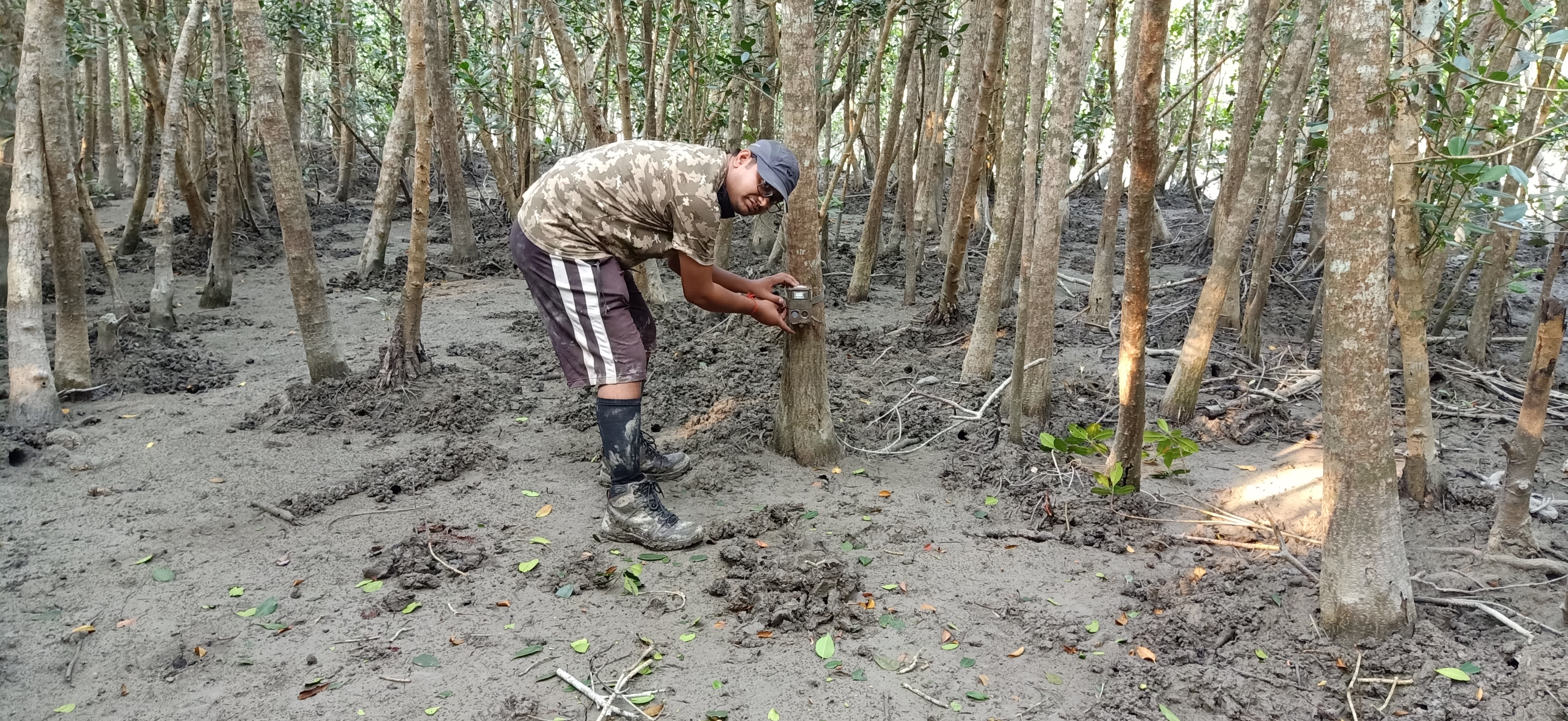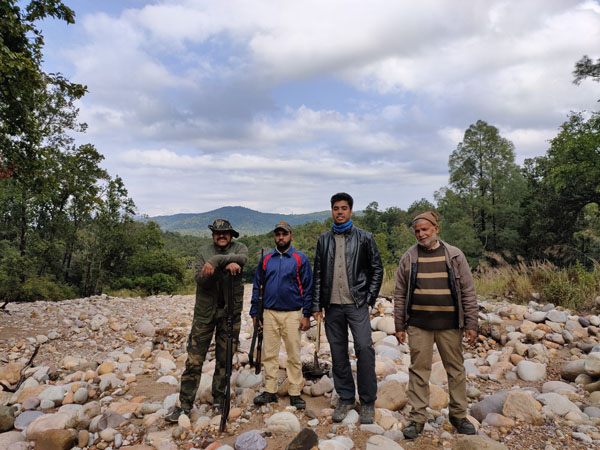
Debmalya Roy Chowdhury works as a Senior Project Officer in the mighty Sundarbans Landscape in West Bengal. The dynamic yet shy 36-year-old has been part of our tiger conservation efforts for a decade now.
His journey to protect tigers started way back in 2009. “I ventured into the world of tigers while working with the Wildlife Institute of India. I was part of a project to study, estimate, and evaluate tiger population status. A couple of years later, I joined WWF India as a Project Officer in the Terai Arc Landscape, Uttarakhand, in 2011. Soon I shifted my base to Kolkata and joined our Sundarbans Landscape team.” he says.
Debmalya brings a wealth of knowledge regarding wildlife and ecology research, project management, and building relationships with communities for awareness generation.
“I try to address complex conservation challenges at a landscape level. I feel that I am one of the luckiest members of the Panda family to work in the world’s only mangrove tiger habitat for so long!” chuckles Debmalya, smiling ear to ear.
The region is particularly vulnerable to the impacts of climate change - threatening the safety and livelihood of local communities. Other challenges include high negative human-wildlife interactions and exploitation of natural resources.
“Apart from being home to tigers and other iconic wildlife, the Indian Sundarbans is also home to 4.5 million people. The region directly supports subsistence activities like fishing, crab hunting, and the collection of non-timber forest products. Access to such resources, except in the Protected Areas, plays an important role in supporting the livelihoods of a growing human population. With declining agricultural productivity due to soil erosion and extreme weather events engulfing croplands with saline water, traditional farmers are switching to fishing. But fishing in the estuaries leads to several incidents of negative human-tiger interactions with losses heavy at both the ends.” he observes.
The Forest Directorate and Government of West Bengal have installed nylon nets to deter tigers straying into villages. Much to the relief of communities, no straying tiger has been killed since 2001. Debmalya clearly feels reassured by this.

Debmalya deploying camera traps in the Sundarbans Landscape.
“WWF India, in collaboration with the SBR (Sundarbans Biosphere Reserve) and the FD (Forest Department) has been instrumental in providing timely support to handle conflict situations. We are supporting our key stakeholders with improved tools and methods to mitigate negative human-tiger cases. Our teams have designed Advanced Trap and Transfer Actions Cage and installed solar street lights in the region. Providing technical support to stakeholders is our focus, too.” he says.
While our planet is changing rapidly around us, Debmalya cites climate change and natural habitat destruction as critical drivers to such alterations - affecting both people and wildlife. “I want to contribute towards preserving our natural habitats and save enigmatic wild animals like tigers so that my next generation can live in harmony with nature.” firmly points out Debmalya.

Rahul Talegaonkar is one of WWF India’s young tiger conservationists. Posted in the Balaghat tiger recovery site in Madhya Pradesh, the 32-year-old wildlife researcher and tiger expert has tackled many odds to pursue his dreams.
“I was never outstanding in my academics. However, I had an immense interest in Biology and fared well in the subject. Likewise, my family members have always been animal lovers — and it rubbed off on me too. As a young child, I remember going to the Kanha National Park to catch a glimpse of tigers every year. My interest and curiosity in wildlife, especially tigers, started at a very young age. The culmination of all these experiences encouraged me to pursue a career as a wildlife conservationist!” Rahul quips fondly.
A self-taught wildlife photographer, Rahul has captured tigers extensively. "My most cherished tiger photograph has been Munna (T-17) – known once as the most popular resident in the Kanha National Park. Sadly, the 19-year-old feline passed away this year owing to old age. Munna was most recognised globally because of the characteristic stripes on his forehead which read 'CAT'!" reminisces Rahul.

Seen here is Munna (T-17) photo captured by Rahul.
He has worked earlier with the Bombay Natural History Society studying the Bengal Floricans and the Wildlife Institute of India, monitoring tigers, co-predators, prey, and their habitats. Later in 2018, Rahul joined as a Senior Program Officer in our Central India Landscape team.
His day starts with going into the field, overlooking the undulating Maikal hills and vast stretches of forest in the Balaghat district. Home to approximately 30 tiger individuals, it is strategically encircled by several critical wildlife corridors including the popular Kanha-Pench corridor.
Rahul emphasizes the uniqueness of the Balaghat tiger recovery site, which is one of the few non-Protected Areas in Madhya Pradesh with tigers!
"The Balaghat tiger recovery site is a remarkably tricky region – it is neither a tiger reserve, a national park, nor a wildlife sanctuary. The proposed TX2 site is a territorial forest! It has a thriving tiger population along with documented sightings of other mammalian species. These include hyenas, dhole, and Eurasian otter spotted outside of the state's Protected Area, making it more important to boost conservation measures in the region.” points out Rahul.
The forests of Balaghat are connected to Kanha, Pench, and Navegaon-Nagzira Tiger Reserves. Rahul confirms that linking healthy source populations of Kanha and Pench makes Balaghat a significant site for recovering tigers in Madhya Pradesh.

Moving to Northern India, we meet Shariq Shafi, our Project Officer - Species Conservation, working in the rugged terrains of the Terai Arc Landscape in Uttarakhand.
Crediting his father for instilling a profound love for wildlife and nature, Shariq recollects his childhood memories of watching wildlife documentaries playing VHS tapes. “Way back in 1999, broadcasting channels like Discovery was limited to mega-cities. So, my father got these low-quality VHS tapes for me. The calls of spotted deer and the sound of wildebeest, cape buffalo, and zebras when they spotted tigers and lions on the hunt still rings in my ears.” laughs Shariq.
A fascination with wildlife that started at a young age inspired Shariq to become a conservationist. Before joining WWF India, he worked with the Uttar Pradesh Forest Department as a Field Biologist in the Katerniaghat Wildlife Sanctuary along the picturesque Indo-Nepal border.
He attributes WWF India to shaping his dreams and work in the field of conservation.
“I joined WWF India in 2016. My first posting in the Valmiki Tiger TR (Tiger Reserve), Bihar, introduced me to the world of large carnivores. I learned to estimate tigers along with other co-predators by using intensive camera trappings and sign surveys. I have been part of continuous tiger monitoring exercises across important sites like the Valmiki TR and the Dudhwa TR, among others.” says Shariq.
Apart from estimating tiger numbers, he has also played a significant role in streamlining the GPS-based patrolling tools like SMART (Spatial Monitoring and Research Tool) and MSTrIPES (Monitoring System of Tigers, Intensive Patrolling and Ecological Status) across few protected areas in the Terai Arc Landscape. He highlights that poaching remains one of the major threats to the survival of tigers.

Shariq with the Forest Department staff while monitoring tigers in the Corbett Tiger Reserve.
"It is challenging to stop poaching incidences. However, we were determined to stop the poaching of tigers and other animals in the Valmiki Tiger Reserve in Bihar, the Amangarh Tiger Reserve in Uttar Pradesh, and the Nandhaur Wildlife Sanctuary in Uttarakhand. Therefore, our field teams introduced these tools to support the efforts of the forest staff and protect the region more efficiently. I have trained more than 600 staff to use SMART and MSTrIPES tools. It enables the forest department to record patrolling efforts, animal signs, and other information to stop poaching in the region."
Besides rigorously building the capacity of the frontline forest staff on wildlife monitoring, Shariq also works closely with local communities.
Stationed in Haldwani, Shariq looks after species monitoring exercises around the Corbett Landscape which experiences high negative human-wildlife interactions. With more than 90 villages and urban settlements within the Corbett Tiger Reserve (CTR) vicinity coupled with a large population of tigers, elephants, and leopards, the landscape becomes a hotspot for chance wildlife encounters. Such incidents are largely restricted to livestock depredation by tigers and leopards.
"Loss of livestock around the CTR distresses the community. In collaboration with the Corbett Foundation, we implement the Interim Relief Scheme project in the area. The scheme intends to provide timely relief to affected communities. This helps to avoid chances of carcasses poisoning and promote harmonious co-existence between local communities and large carnivores like tigers.... We always identify practical solutions to fight rising human-wildlife encounters. Our teams in association with the Forest Department have deployed early warning systems, solar power fences and lights," Shariq patiently explains.
Thanks to such measures and advanced technologies, communities can now sleep peacefully in the night. And that is Shariq’s rich reward of a hard day's work!
It is clear that the concerted efforts of all our brave tiger experts allow much to reflect. Most of us would not have a clue of the range and intensity of work our tiger conservationists perform each day. From studying the elusive big cat to working in treacherous and unforgiving remote terrains - the future of tigers is undoubtedly in good hands.